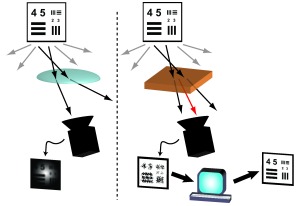Juli 7, 2009
Nanotech Europe 2009, an annual conference and exhibition on nanotechnology will be held in Berlin, Germany from September 28-30, 2009. The event offers a broad, interdisciplinary overview of nanotechnology, and the opportunity to meet and discuss with the field’s top scientists and international companies in the nanotechnology community. The fifth Nanotech Europe has a broad scope, covering leading-edge research, industrial applications and cross-cutting topics including electronics, photonics, materials, health and bio, instrumentation, energy as well as safety and investment. In total, 36 sessions will be held by over 180 speakers from both academia and industry.
www.nanotech.net

Brandenburger Tor, Berlin, Germany (source: pixelio.de)
 Leave a Comment » |
Leave a Comment » |  Events | Verschlagwortet: Berlin, Bio, electronics, energy, Europe, health, instrumentation, investment, materials, nano, nanotechnology, photonics, safety |
Events | Verschlagwortet: Berlin, Bio, electronics, energy, Europe, health, instrumentation, investment, materials, nano, nanotechnology, photonics, safety |  Permalink
Permalink
 Veröffentlicht von aszerdi
Veröffentlicht von aszerdi
April 29, 2009
A new imaging method that could help to build more powerful microscopes and other optical devices by producing sharper images and a wider field of view has been developed by Princeton researches. The research was led by Jason Fleischer, assistant professor of electrical engineering and co-written with two graduate students Christopher Barsi and Wenjie Wan. The new method takes advantage of the unusual properties of nonlinear optical materials in which light rays mix with each other in complex ways. Thanks to the mixing of rays, information that would otherwise be lost manages to reach the detector. Therefore this picture would be rich in detail but it would also be distorted. To capture this otherwise lost visual information, the researchers used a hologram. The hologram is a special type of photograph which records „phase“ – a light property which measures the time and location of a wave peak. They also combined data from a normal camera. Then they created a simplified flow of light through a nonlinear material and developed a computer algorithm that takes the distorted image and works backwards to calculate the visual information at every point in space between the image and the object.
www.princeton.edu

An object illuminated by light reflects rays in many different directions (gray arrows). Left: With a normal lens, some rays are captured and refract towards a camera while others are missed, resulting in a blurry image with a limited field of view. Right: The new method uses a nonlinear material. The original rays are altered and new rays (red) are generated. The resulting picture is scrambled, but a computer algorithm can undo the mixing and yield a sharp, wide-field image. (Image: Christopher Barsi)
 Leave a Comment » |
Leave a Comment » |  Research & Development | Verschlagwortet: algorithm, arrows, Barsi, Christopher Barsi, computer, detector, distortion, hologram, images, imaging, Jason Fleischer, light, linear, materials, microscopes, microscopy, nonlinear, object, optical, optics, phase, Princeton, rays, refraction, sharp, techniques, view, visual, Wan, Wenjie Wan, wide-field |
Research & Development | Verschlagwortet: algorithm, arrows, Barsi, Christopher Barsi, computer, detector, distortion, hologram, images, imaging, Jason Fleischer, light, linear, materials, microscopes, microscopy, nonlinear, object, optical, optics, phase, Princeton, rays, refraction, sharp, techniques, view, visual, Wan, Wenjie Wan, wide-field |  Permalink
Permalink
 Veröffentlicht von aszerdi
Veröffentlicht von aszerdi
April 27, 2009
Asylum Research, in conjunction with IMETUM, Nano Initiative Munich, and Atomic Force F&E, announces the 2nd Euro AFM Forum to be held at the Technical University of Munich (TUM), Garching, Germany, July 1-3, 2009. The event is a conference for AFM researchers to share their cutting-edge research for both materials and life science applications. The forum will combine invited and contributed talks from leading European researchers as well as instructional workshops on AFM equipment. Workshop topics include cell imaging, imaging in liquids, force spectroscopy, electrical characterization and more.
Participants are invited to submit their best AFM image for the Forum Image Contest. An iPod Nano will be awarded for the best image that represents innovative science and has the „cool“ factor. The deadline for submission is June 1, 2009.
www.atomicforce.de/Euro-AFM-Forum-2009.php

Surface of a Chestnut, DC mode in air. Taken by Thomas Gutsmann, Research Center Borstel, Germany (participant of the 2007 event).
 Leave a Comment » |
Leave a Comment » |  Awards, Events | Verschlagwortet: AFM, Asylum, atomic, cells, characterization, contest, cool, cutting-edge, electrical, Euro, Euro Atomic Force Microscopy Forum, force, forum, images, imaging, IMETUM, initiative, life sciences, liquids, materials, microscopy, nano, Nano Initiative Munich, spectroscopy |
Awards, Events | Verschlagwortet: AFM, Asylum, atomic, cells, characterization, contest, cool, cutting-edge, electrical, Euro, Euro Atomic Force Microscopy Forum, force, forum, images, imaging, IMETUM, initiative, life sciences, liquids, materials, microscopy, nano, Nano Initiative Munich, spectroscopy |  Permalink
Permalink
 Veröffentlicht von aszerdi
Veröffentlicht von aszerdi
Januar 13, 2009
The key challenges and issues the world microscope market is facing were recently published in the report “World Microscopes Market” on the market research engine Reportlinker. The specific product segments analyzed are Optical Microscopes, Charged Particle Microscopes, and Scanning Probe Microscopes. The report also contains an assessment of the world market by end-use applications like Semiconductor Manufacturing, Life Sciences, Materials and Nanotechnology. Further, this market research provides separate comprehensive analytics for the US, Canada, Japan, Europe, Asia-Pacific, Middle East, and Latin America and includes a forecast for each region for the period of 2000 through 2015. The report profiles 105 companies including many key and niche players worldwide, for which data were mostly extracted from URL research and reported select online sources. The market data and analytics are derived from primary and secondary research.
See Reportlinker
 Leave a Comment » |
Leave a Comment » |  Newsflow | Verschlagwortet: analysis, applications, assessment, business, data, forecast, market, materials, microscopes, microscopy, nanotechnology, optical, particle, probe, report, research, scanning, sciences, semiconductor, sources |
Newsflow | Verschlagwortet: analysis, applications, assessment, business, data, forecast, market, materials, microscopes, microscopy, nanotechnology, optical, particle, probe, report, research, scanning, sciences, semiconductor, sources |  Permalink
Permalink
 Veröffentlicht von aszerdi
Veröffentlicht von aszerdi




 Veröffentlicht von aszerdi
Veröffentlicht von aszerdi 
